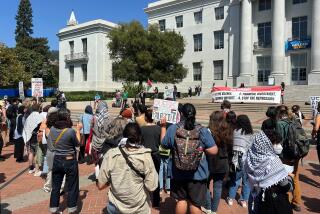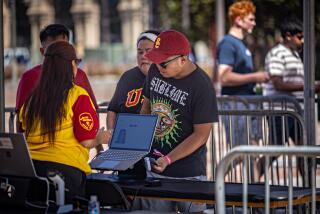CAMPUS CORRESPONDENCE : How Our Biggest News Story Almost Got Away
- Share via
It should have been an easy task.
The newspaper was already laid out in preparation for the Jan. 17 deadline of the 35,000-issue mail-out registra tion edition. I, of course, knew what the headline would read: Earthquake.
It took three hours to drive the 20 miles to campus. Once there, I flashed my press pass at one of the police officers who surrounded the university.
“The campus is closed to everyone.”
That was 20 days ago--and still no paper. Since the Northridge earthquake, my staff and I had assembled photos and stories that, in a morbid sort of way, are the envy of any university newspaper in the country.
We had spoken to some of the survivors of the Northridge Meadows, where 16 people, including two Cal State Northridge students, were killed when the apartment complex pancaked. We had stories on students, some of whom had never experienced an earthquake, who told tales of being homeless and of sleeping in tents. We had interviews with state senators, a congressman and CSUN President Blenda J. Wilson.
We had photos of the university’s science complex in flames, its library in shambles and its $14-million “earthquake resistant” parking structure splattered.
So why did the Sundial sit on the most important edition in its entire history?
The building that houses the Sundial offices has officially been declared “stable” and safe to re-enter, but staff members are not allowed in. Not even for five minutes, which was all the time needed to get the ads that were sold for the mail-out edition. The administration, apparently, was unwilling to allow the Sundial to be published without the $18,000 worth of ads.
Is this any way for a college newspaper to operate? Especially at a time of extraordinary circumstances, when students, more than ever, are dependent for information on the newspaper?
Wilson and other administrators have been supportive. “We want you to get a paper out; you’re our only link to the student,” they told us. “You have our support. Do whatever it takes.”
As long as it doesn’t cost $18,000.
But why did the administration spend a whole lot more money to buy ads in The Times and Daily News to convey the same information to students that the Sundial edition would have? To add insult to injury, the journalism department even considered having us publish a four- to eight-page follow-up quake edition-- without ads.
Fortunately, as a result of the generosity of California State University, Los Angeles, which allowed us to use its facilities, the edition of a lifetime was mailed out Thursday--with the ads. But should the “only link to the student” be held hostage to the bottom line at a time when the need to know can mean the difference between life and death?*
More to Read
Sign up for Essential California
The most important California stories and recommendations in your inbox every morning.
You may occasionally receive promotional content from the Los Angeles Times.













